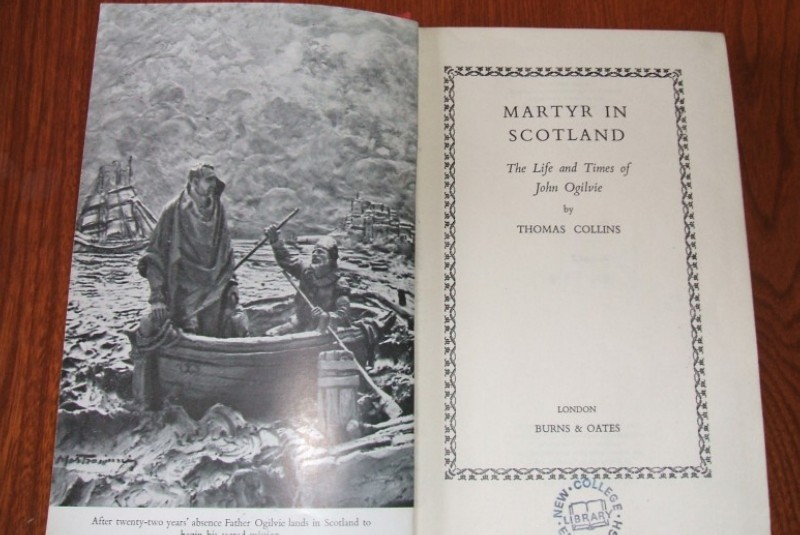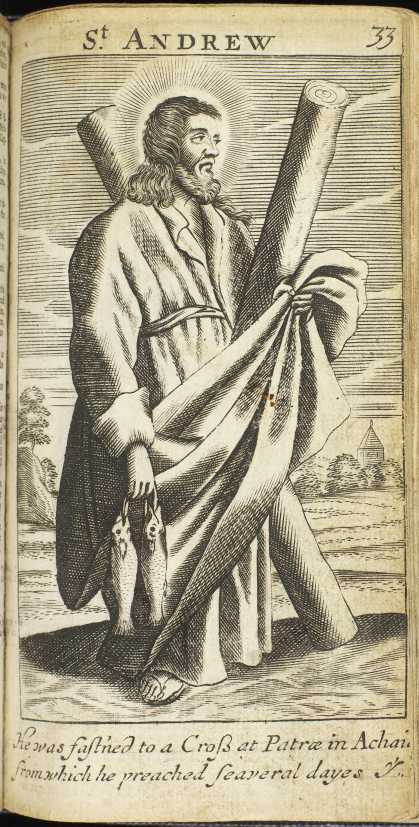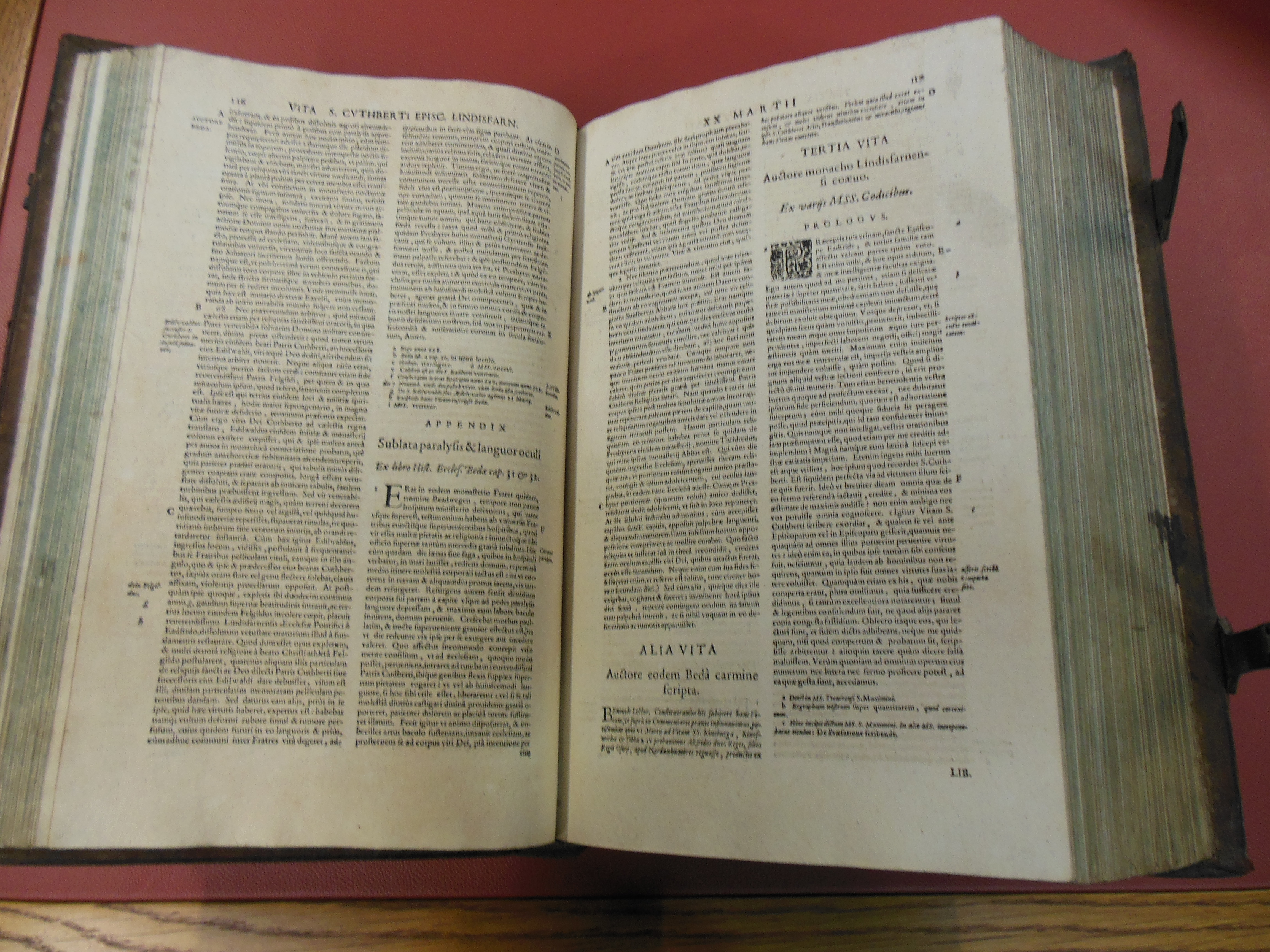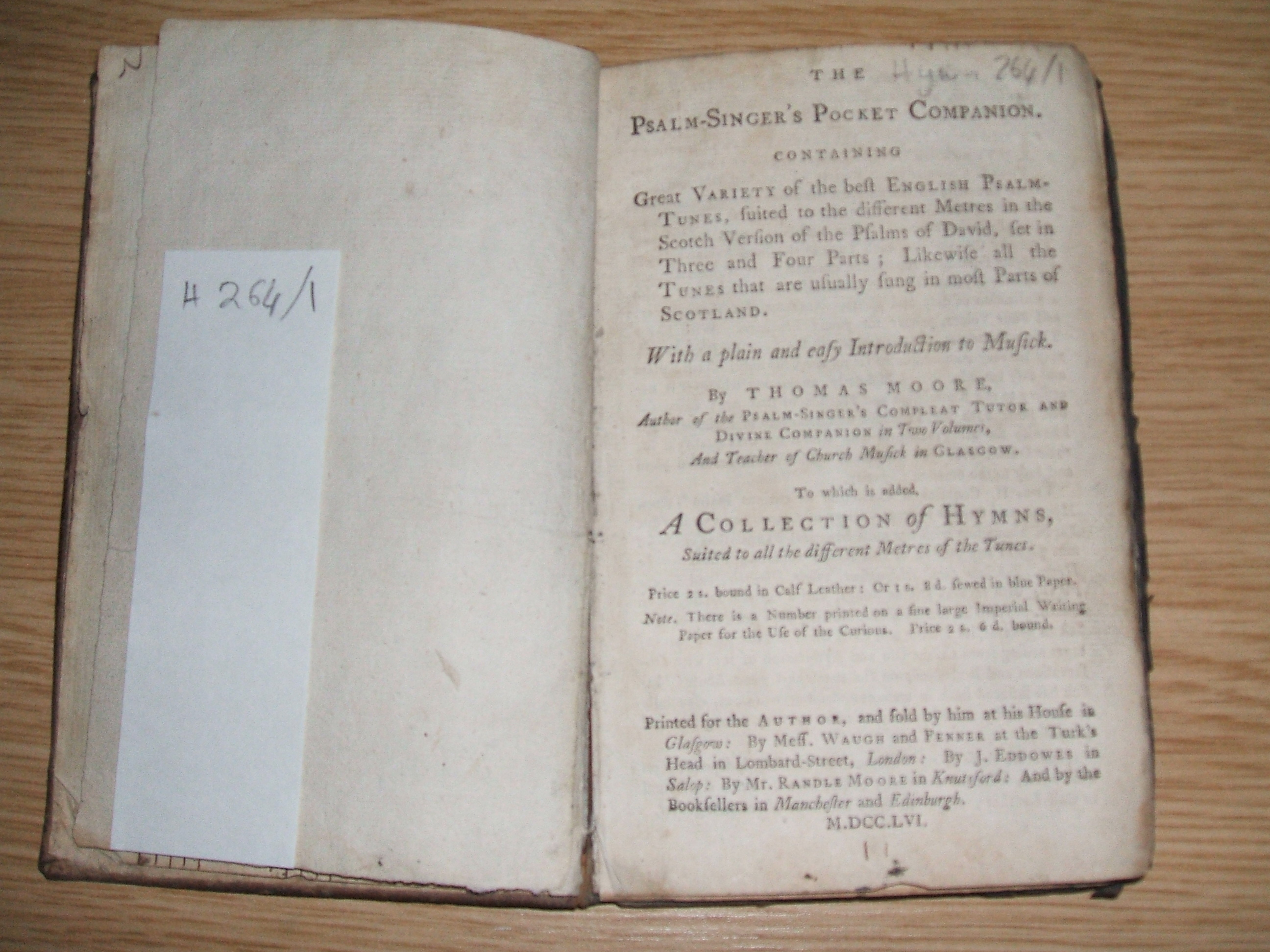We welcomed University of Edinburgh MSc Medieval History students today for a tour of New College Library and the chance to see one of the texts they were studying, the Life of St Cuthbert, in New College Library’s first edition of the Acta Sanctorum, which was on display in the Funk Reading Room. Published in the seventeenth century, the Acta Sanctorum, which contains the first printed edition of this work, is a huge Latin work in sixty-eight volumes examines the lives of saints, organised according to each saint’s feast day in the calendar year. This image shows the large folio volume, still in its original leather binding with metal clasps, open at the Life of St Cuthbert. The Acta Sanctorum is also available online to University of Edinburgh users.
Tag Archives: saints
Early printed works of St Anselm on display at New College Library
 New on display in the Funk Reading Room is the Works of St Anselm, Opuscula beati Anselmi archiepiscopi Ca[n]tuarie[n]sis ordinis Sancti Benedicti, printed in 1497.
New on display in the Funk Reading Room is the Works of St Anselm, Opuscula beati Anselmi archiepiscopi Ca[n]tuarie[n]sis ordinis Sancti Benedicti, printed in 1497.
April 21 is the Feast Day of St Anselm (1033-1109). A Benedictine monk who lived during the reigns of William the Conqueror and William Rufus, he became the abbot of the monastery at Bec in Normandy, France. Named as Archbishop of Canterbury in 1093 by William Rufus, under the rule of Henry I Anselm faced the challenges of preserving the secular and spiritual rights of the Church in the face of the authority of the King. Despite these political difficulties, Anselm held two great ecclesiastical councils at Lambeth and York where many decrees for church reform were made.
Anselm’s prayers and meditations (accessible online to University of Edinburgh users in the Patrologia Latina) had a lasting influence through the middle ages, but his writings also made a significant contribution to theological debate into the twentieth century and beyond.
New College Library holds two copies of Anselm’s works in the Incunabula Collection, which was recently catalogued online as part of the Funk Cataloguing Projects.
Sources
D.H. Farmer, ‘Anselm (1033-1109)’, The Oxford Dictionary of Saints, Oxford University Press, 2011; online edn 2012 [http://www.oxfordreference.com, accessed 17 April 2013]
R. W. Southern, ‘Anselm [St Anselm] (c.1033–1109)’, Oxford Dictionary of National Biography, Oxford University Press, 2004; online edn, Oct 2009 [http://www.oxforddnb.com/view/article/572, accessed 17 April 2013]
Scotland’s last saint : St John Ogilvie
 The 10th of March is celebrated as the feast day of St John Ogilvie in the Roman Catholic Church. The only post-Reformation saint from Scotland. John Ogilvie (1578/9–1615) was born and brought up as a Calvinist in Strathisla, Banffshire. After studying at the Protestant University of Helmstedt in northern Germany, he became a Catholic, and after further study took his vows as a Jesuit priest in 1601. Ogilvie volunteered for missionary work in Scotland, and arrived in Leith in 1613. Ogilvie’s work was to administer the sacraments to Catholics, bring doubters back to the fold, and seek new converts throughout Edinburgh, Glasgow and Renfrewshire. It On 4 October 1614 he was betrayed and captured while walking in a Glasgow street. The authorities’ narrative of his trial and execution was printed as A true relation, of the proceedings against Iohn Ogiluie, a Iesuit … (1615), available to University of Edinburgh users via Early English Books Online. While other Catholics suffered trial and imprisonment at this time, “Ogilvie was the only Catholic in Scotland ever to be judicially sentenced and executed for his religion” (1).
The 10th of March is celebrated as the feast day of St John Ogilvie in the Roman Catholic Church. The only post-Reformation saint from Scotland. John Ogilvie (1578/9–1615) was born and brought up as a Calvinist in Strathisla, Banffshire. After studying at the Protestant University of Helmstedt in northern Germany, he became a Catholic, and after further study took his vows as a Jesuit priest in 1601. Ogilvie volunteered for missionary work in Scotland, and arrived in Leith in 1613. Ogilvie’s work was to administer the sacraments to Catholics, bring doubters back to the fold, and seek new converts throughout Edinburgh, Glasgow and Renfrewshire. It On 4 October 1614 he was betrayed and captured while walking in a Glasgow street. The authorities’ narrative of his trial and execution was printed as A true relation, of the proceedings against Iohn Ogiluie, a Iesuit … (1615), available to University of Edinburgh users via Early English Books Online. While other Catholics suffered trial and imprisonment at this time, “Ogilvie was the only Catholic in Scotland ever to be judicially sentenced and executed for his religion” (1).
In the nineteenth century John Ogilvie was rediscovered with the publication of Scottish historical sources, leading to the publication of a number of works on his life. New College Library holds Jean Ogilvie, ecossais, jesuite : torturé et mis à mort pour la foi by James Forbes, (Paris : 1901) and Martyr in Scotland : The life & times of John Ogilvie by Thomas Collins (London: 1955). John Ogilvie was beatified in 1929 and canonized in 1976.
(1) Mark Dilworth, ‘Ogilvie, John [St John Ogilvie] (1578/9–1615)’, Oxford Dictionary of National Biography, Oxford University Press, 2004 [http://www.oxforddnb.com/view/article/20586, accessed 28 Feb 2013]
The saint, the saltire and a Scottish legend

The Holy Bible : containing the Old and New Testaments … Oxford : Printed by the University Printers, 1695. New College Library B.r.468
Today, November 30, is Saint Andrew’s day, also celebrated as Scotland’s national day.
The Oxford Dictionary of Saints (available online to University of Edinburgh users) notes that the cult of St Andrews was evident in England from Anglo-Saxon times, when the church in Rochester was the earliest of 637 medieval dedications to St Andrew. His legend grew to include the translation of his relics from Patras to Scotland by St Rule or Regulus in the 8th century. It is said that under angelic instruction, St Rule stopped at the place in Fife now known as St Andrews and built a church there, which became a centre for Christian evangelization and learning. St Andrew is commonly depicted with the saltire cross (X), which is used to represent Scotland on the Union Jack.
This image of St Andrew, patron saint of Scotland, comes from a seventeenth century English Bible which contains attractive illustrations of Bible scenes and pictures of the saints. It has bound with it metrical Psalms in the version of the Scottish Psalter, 1564. It is part of New College Library’s Early Bibles Collection, catalogued online as part of the Funk Cataloguing projects.
Psalms for St Cecilia’s Day
The feast of St Cecilia’s Day is traditionally celebrated on November 22nd. A 3rd century martyr, St Cecilia is known as the patron saint of musicians. Her legend relates that, as a young Christian, she was betrothed to a pagan but she had already vowed her virginity to God. As the organs played at at her wedding feast, Cecilia sang (in her heart) to the Lord, asking that her heart remain pure.
Here’s a book of Psalms to remember her by. Thomas Moore’s Psalm singers’ pocket companion is a publication from the revival era known as Gallery Psalmody, where leading singers and choir were located in a loft of the church. The new style lasted for about a century from 1755, and its main features were choirs singing in harmony of usually three parts, with some solo sections. Thomas Moore (- d. 1792) was a music teacher from Manchester Cathedral who came to Glasgow to teach singing.
 This item is small, or pocket sized, and contains a number of manuscript doodles which may testify to the singer’s mind wandering elsewhere. Also interesting are the pages of handwritten music staves, perhaps to allow the singer to make notes of new tunes or harmonies.
This item is small, or pocket sized, and contains a number of manuscript doodles which may testify to the singer’s mind wandering elsewhere. Also interesting are the pages of handwritten music staves, perhaps to allow the singer to make notes of new tunes or harmonies.
The Psalm singers’ pocket companion belongs to the Hymnology Collection, and was catalogued as part of the Funk Cataloguing Projects. With thanks to our Project Cataloguer, Oreste de Tommaso, for supplying details of this item.
Acta Sanctorum now available online to University of Edinburgh
 The online Acta Sanctorum, published by ProQuest Databases, is now available to University of Edinburgh users. It is an electronic version of the complete printed text of Acta Sanctorum,which examines the lives of saints, organised according to each saint’s feast day, and runs from the two January volumes published in 1643 to the Propylaeum to December published in 1940. The original printed volumes are held in New College Library’s Special Collections.
The online Acta Sanctorum, published by ProQuest Databases, is now available to University of Edinburgh users. It is an electronic version of the complete printed text of Acta Sanctorum,which examines the lives of saints, organised according to each saint’s feast day, and runs from the two January volumes published in 1643 to the Propylaeum to December published in 1940. The original printed volumes are held in New College Library’s Special Collections.
University of Edinburgh registered users can access the database via the link on the Library’s A-Z Databases page.
Treasures of New College Library : the Acta Sanctorum
Down in the depths of New College Library’s Stack III, one of the first rows of shelves that faces you when you enter contains the Acta Sanctorum. This huge Latin work in sixty-eight volumes examines the lives of saints, organised according to each saint’s feast day in the calendar year. Fifty-three of the volumes were published between 1643 and 1794 by the Bollandist Fathers in Antwerp. Hugh Watt, in his New College Library : A Centenary History (Edinburgh: Oliver and Boyd, 1946), relates a story that Cardinal Hume had intended to purchase this set of the Acta Sanctorum for himself as a birthday present, but arrived at the bookseller’s only to find that Dr William Cunningham, second Principal of New College, had beaten him to it and purchased the volumes for New College Library.

University of Edinburgh users have trial access to the online Acta Sanctorum Database until 24 May 2012. The Acta Sanctorum Database contains the entire Acta Sanctorum, including all prefatory material, original texts, critical apparatus and indices. Bibliotheca Hagiographica Latina reference numbers, essential references for scholars, are also included.


